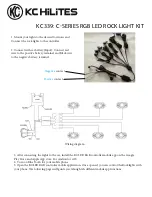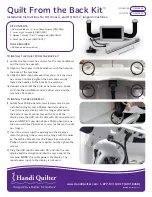
3
ITI® Aritech APW 450 PIR Motion Sensor
Programming
Preliminary 4/18/00
6.
When testing is completed the PIR can be securely
attached to its mounting plate by screwing the smallest
enclosed screw into the hole at the top of the mounting
plate.
Setting the Sensitivity on the Indoor
Motion Sensor
For pet applications, the PIR must be set to standard sensi-
tivity.
Walk Testing the Motion Sensor
Walk testing should be done to determine the sensor’s
actual coverage area. The edge of the coverage pattern is
determined by the first flash of the LED. This may change
slightly depending upon the sensitivity setting. Walk test
the unit from both directions to determine the pattern
boundaries.
1.
Remove the sensor body from the mounted mounting
plate, activate the tamper switch, and then remount the
body to activate the 60 second walk test mode.
2.
Walk across the coverage pattern to determine the cov-
erage area, indicated by LED activation. Each activa-
tion extends the walk test mode for an additional 60
seconds.
After 60 seconds without motion the walk test mode and the
LED will no longer activate when motion is detected.
CAUTION
Excessive use of the walk test mode may reduce
battery life. Use only for initial setup and maintenance
testing.
Note
When the walk test mode has ended, an alarm can be
transmitted only after 3 minutes have passed since
the previous alarm. This 3 minute lockout time
reduces unnecessary RF transmissions in high traffic
areas thereby extending battery life.
Environment Testing
Turn on all heating or air conditioning sources which would
normally be active during the protection period. Stand
away from the sensor and outside the coverage pattern and
watch for alarms.
Programming
Refer to the panel installation manual for information on
programming the sensor into the panel.
To trip the sensor:
1.
Remove the back cover to activate the tamper switch.
2.
Exit the panel’s programming mode.
3.
Return the PIR to its mounting plate.
Maintenance
At least once a year, the range and coverage should be veri-
fied for proper operation. The end user should be instructed
to put the sensor in walk test mode and walk through the far
end of the coverage pattern to verify proper detection.
Replacing Batteries
When battery replacement is necessary, observe proper
polarity (as shown in the battery compartment) when
installing the new battery, or the sensor may be damaged.
Be sure to note that as you look at the battery compartment,
on the left side the positive side is down and on the right
side the positive end is up. When the battery is replaced,
wait at least 3 minutes after installing the battery before
activating the walk test mode.
Final Testing
Final testing should be done to verify radio signal integrity
and confirm control panel programming and response. The
actual transmitter range can be determined by performing a
sensor test as follows:
1.
After the sensor has been mounted, remove it from its
mounting plate and activate the tamper switch to start
the walk test mode.
2.
Replace the sensor in its mounting plate
3.
Place the control panel in test mode. Move across the
detection pattern until the sensor’s LED turns on.
STOP your motion.
4.
Listen for the appropriate system response. If the sys-
tem does not respond, proceed to Troubleshooting sec-
tion.
Troubleshooting
Use the following guidelines if the system does not respond
correctly when the sensor is activated.
❑
Check programming and re-program sensor into panel
if necessary.
❑
Move the sensor to another location and test for correct
response.
To relocate a sensor:
1.
Test the sensor a few inches from the original position.
2.
Increase the distance from the original position and
retest until an acceptable location is found.
3.
Mount the sensor in the new location.
4.
If no location is acceptable, test the sensor as follows:
❑
Test a known good sensor at the same location.






















